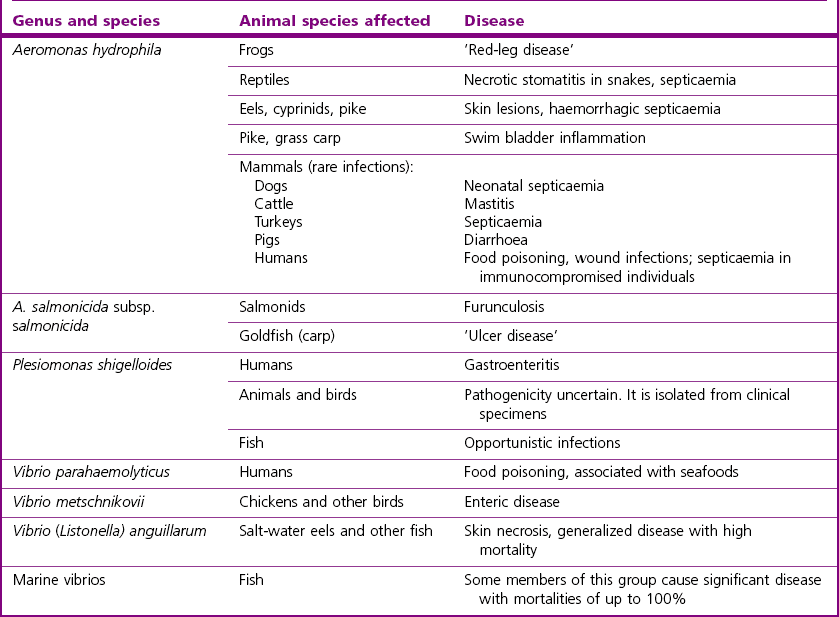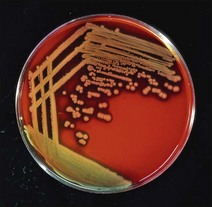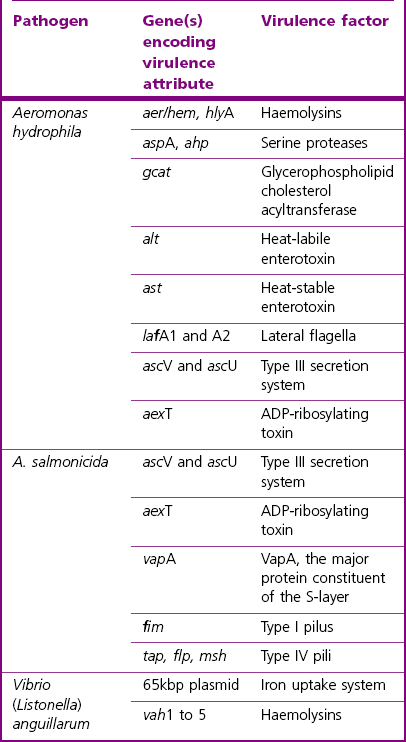Chapter 19 Aeromonas hydrophila is an opportunistic pathogen causing disease in fish and reptiles with rare reports of infections in mammals. The organism is important in fish suffering from stress or weakened by the presence of other diseases. As it is ubiquitous in aquatic environments, its importance as a secondary invader is not surprising when husbandry conditions in aquaculture are suboptimal. Aeromonas hydrophila produces a range of putative virulence factors including adhesins, exoenzymes, haemolysins, enterotoxins and an acyltransferase toxin secreted by a type III secretion system (Yu et al. 2004, Li et al. 2011). Aeromonas hydrophila can occasionally cause infections in humans that range from wound infections to septicaemia to self-limiting diarrhoea in children, as well as food poisoning. There are apparent differences between environmental and human clinical isolates but environmental isolates possess a wide range of virulence factors also and further studies are required to clarify their roles (Aguilera-Arreola et al. 2005). Aeromonas salmonicida is an obligate parasite of salmonid fish, causing furunculosis. As with A. hydrophila infections, acute or chronic stress is important and may trigger inapparent infections to become clinical. Virulence factors of A. salmonicida include its outer protein coat, the S-layer, which functions as an adhesin, Type I and Type IV pili and a Type III secretion system (Dacanay et al. 2006, 2010). At least five Vibrio species are human pathogens including V. cholerae, the cholera bacillus, and V. parahaemolyticus which causes food poisoning. Only V. metschnikovii is associated with disease in domestic animals. It causes a cholera-like disease in chickens and other birds but its geographical distribution is very limited. There are a large number of marine vibrios, including V. anguillarum (Listonella anguillarum) which cause infections in many species of fish. The pathogenicity of many of the newly identified species of marine vibrios was reported by Austin et al. (2005). A summary of the diseases of veterinary importance caused by Aeromonas, Plesiomonas and Vibrio species is given in Table 19.1. Some of the principal virulence factors which have been identified in these pathogens are listed in Table 19.2. Table 19.1 Diseases and species affected by the principal pathogens in the genera Aeromonas, Plesiomonas and Vibrio All cultures are incubated aerobically: • Aeromonas hydrophila: blood agar and MacConkey agar, at 37°C for 24 hours. • Aeromonas salmonicida: blood agar, furunculosis agar (BD Diagnostics) at 25°C for 48 hours. • Vibrio anguillarum: blood agar composed of nutrient agar base with 2.0% NaCl at 20°C for 48 hours. • Plesiomonas shigelloides, V. metschnikovii and V. parahaemolyticus: nutrient agar or blood agar at 37°C for 24–48 hours. • Aeromonas hydrophila: blood agar with 10 mg/litre ampicillin. CIN agar, which is used for the isolation of Yersinia spp., may also be useful (Janda & Abbott 2010). • Vibrio parahaemolyticus will grow on TCBS agar for V. cholerae and other enteric vibrios and, being halophilic, also grows on mannitol salt agar containing 7.5% NaCl, normally used for the isolation of pathogenic staphylococci. • Aeromonas hydrophila: colonies are large (2–3 mm), flat, greyish and surrounded by a large zone of beta-haemolysis (Fig. 19.1). As some other species of Aeromonas are haemolytic, particularly strains of A caviae, haemolytic activity may not be as useful as previously thought as a means of differentiating A. hydrophila (Abbott et al. 2003). Newly isolated strains have a pungent, foul odour. It grows well on MacConkey agar (Fig. 19.2) often with pale colonies (non-lactose-fermenting), but a minority of strains yield lactose-fermenting colonies. In addition, most Aeromonas strains produce tan to buff-coloured colonies on Trypticase soy agar (Abbott et al. 2003). Figure 19.1 Aeromonas hydrophila on sheep blood agar, usually markedly haemolytic with large colonies after 48 hours. A putrid odour is characteristic of recent isolates.
Aeromonas, Plesiomonas and Vibrio species
Pathogenesis and Pathogenicity

Laboratory Diagnosis
Isolation
Selective media
Identification
Colonial morphology

![]()
Stay updated, free articles. Join our Telegram channel

Full access? Get Clinical Tree



